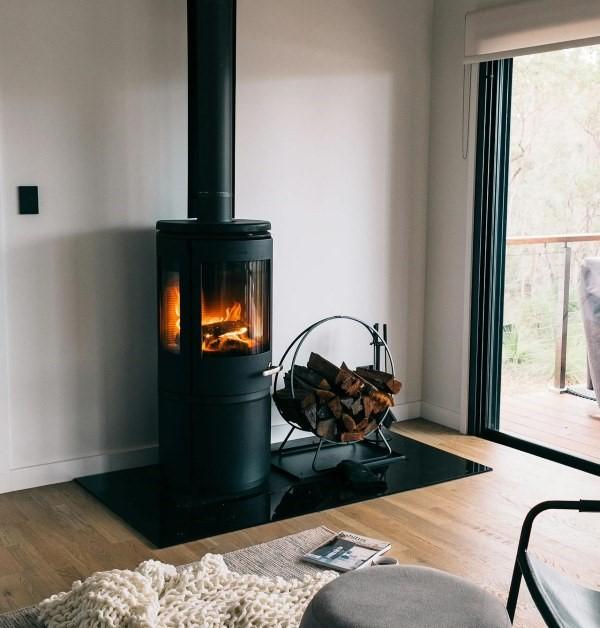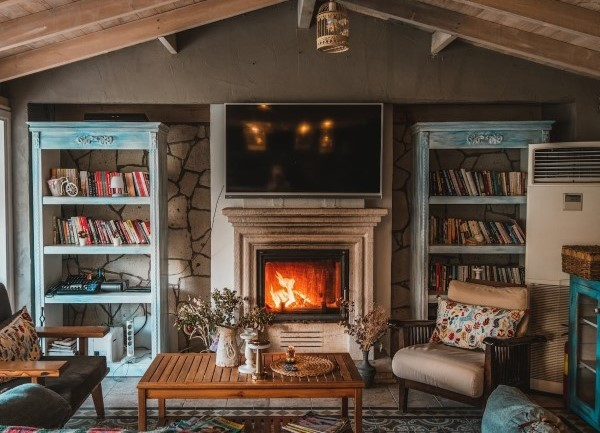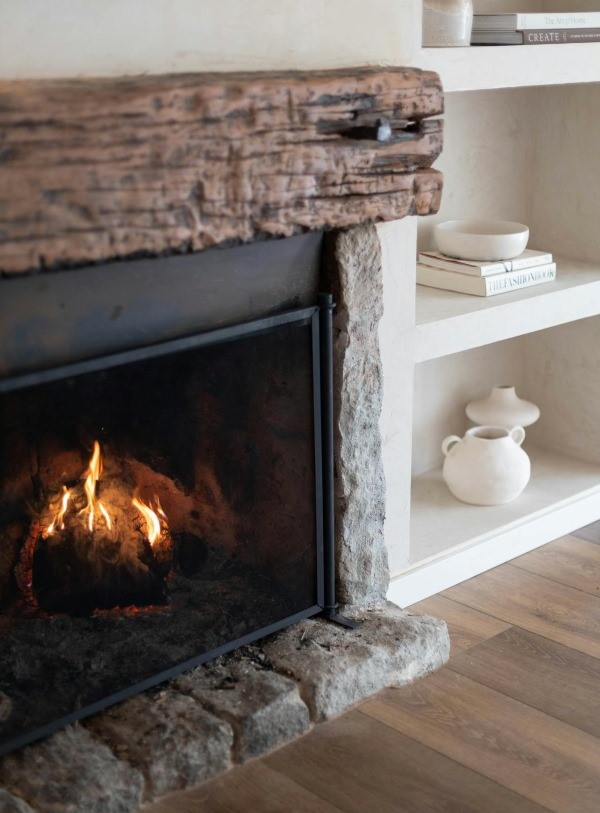Fireplaces have long served as the heart of the home, an architectural feature that provides both warmth and ambiance. Today, they are much more than functional additions; fireplaces are design statements, focal points that elevate a room’s aesthetic and bring a sense of comfort and sophistication. Choosing the right type of fireplace can transform your space, offering elegance that complements your style while creating a cozy sanctuary for every season.
In this guide, we’ll explore various types of fireplaces, from traditional wood-burning to sleek electric models, helping you find the perfect fit for your home’s aesthetic, functionality, and lifestyle.

1. Traditional Wood-Burning Fireplaces
A classic choice that has stood the test of time, the wood-burning fireplace is synonymous with warmth, nostalgia, and timeless charm. With crackling logs and the rich aroma of wood smoke, these fireplaces bring an unmatched sensory experience to any space. Typically built into masonry structures with chimneys, they can be found in historic homes or crafted anew with modern twists.
Key Features:
-
Authenticity and Ambiance: The appeal of a wood-burning fireplace lies in its ability to evoke a cozy, rustic atmosphere.
-
Fuel Source: Requires real firewood, giving a natural warmth and scent that no other fireplace type can replicate.
-
Maintenance: Wood fireplaces require regular cleaning to remove ash and debris, as well as routine chimney inspections.
Design Considerations: Wood-burning fireplaces offer flexibility in style, from grand stone mantels in traditional homes to minimalist, streamlined models in modern interiors. For homeowners seeking an architectural statement, custom masonry can bring unique character to a room, complementing a variety of decor styles.
Pros and Cons:
-
Pros: High heat output, unmatched sensory appeal, wide variety of design styles.
-
Cons: High maintenance, chimney installation required, less eco-friendly than other options.
2. Gas Fireplaces
If you crave the ambiance of a real flame without the upkeep of a wood fireplace, a gas fireplace might be the ideal choice. Gas fireplaces are powered by natural gas or propane, offering the warmth and glow of a wood fire with far less mess. They come in vented and ventless options, making them versatile for various spaces and installations.
Key Features:
-
Ease of Use: With a switch or remote control, gas fireplaces are incredibly user-friendly, turning on and off at your convenience.
-
Consistent Heat Output: Gas fireplaces provide consistent warmth, making them an excellent source of heat for main living areas.
-
Maintenance: While they require occasional professional inspection, gas fireplaces are low-maintenance compared to wood-burning models.
Design Considerations: Gas fireplaces are available in multiple styles, from traditional designs that mimic wood-burning fireplaces to contemporary models that can be recessed into a wall. Linear gas fireplaces, which feature long, sleek frames, are especially popular in modern and minimalist homes, adding a refined touch to any living area.
Pros and Cons:
-
Pros: Low maintenance, efficient heat, convenient operation.
-
Cons: Less realistic than wood, venting required for some models, reliance on gas.
3. Electric Fireplaces
For those seeking an eco-friendly, low-maintenance fireplace solution, electric fireplaces are a compelling choice. Using LED technology, these fireplaces simulate the look of flames, often with customizable colors and flame effects that can suit various decor styles. They don’t require a chimney, venting, or gas line, making them ideal for apartments, rentals, or rooms where adding a chimney or gas line isn’t feasible.
Key Features:
-
Versatility and Safety: Electric fireplaces are safe, with no real flames or emissions, and they’re often cool to the touch, making them ideal for homes with children and pets.
-
Customizable Flame Effects: Many electric models allow users to adjust flame colors, brightness, and speed, tailoring the ambiance to their mood.
-
Easy Installation: Most electric fireplaces are plug-and-play, making installation as simple as placing them in the desired spot and connecting them to an outlet.
Design Considerations: Electric fireplaces come in many styles, including wall-mounted, freestanding, and insert options. They offer endless placement possibilities, from media consoles to accent walls, and can fit seamlessly into contemporary and traditional homes alike.
Pros and Cons:
-
Pros: No emissions, easy installation, highly customizable, low-cost operation.
-
Cons: Limited heat output, requires electricity, lacks the authenticity of real flames.
4. Ethanol Fireplaces
For a modern, eco-conscious option, ethanol fireplaces offer a stylish solution with a real flame that produces no smoke, ash, or soot. Fueled by bioethanol, a renewable alcohol-based fuel, these fireplaces are both environmentally friendly and visually stunning. They don’t require venting, making them perfect for indoor or outdoor spaces.
Key Features:
-
Clean-Burning and Odorless: Ethanol fireplaces burn cleanly without emitting harmful pollutants, creating a healthier indoor environment.
-
Portable and Flexible: Without the need for a chimney or gas line, ethanol fireplaces can be placed in almost any room and are easy to move.
-
Minimalist Design: Many ethanol fireplaces come in sleek, minimalist designs, often in tabletop or wall-mounted formats, enhancing modern and contemporary decor.
Design Considerations: Ethanol fireplaces range from bold, sculptural designs to understated tabletop pieces, offering a modern aesthetic for spaces that prioritize style and ambiance. Their portable nature also makes them a great choice for outdoor patios or balconies, where they can bring warmth and elegance without heavy installation.
Pros and Cons:
-
Pros: No venting required, real flame, portable, low environmental impact.
-
Cons: Limited heat output, requires ethanol fuel, may have a higher operating cost than gas or electric options.
5. Gel Fireplaces
Similar to ethanol fireplaces, gel fireplaces use gel fuel canisters to produce real flames without requiring venting or a chimney. These fireplaces are a fantastic option for decorative purposes, often used to add ambiance rather than substantial heat. Ideal for smaller spaces, gel fireplaces bring a cozy, fire-lit atmosphere without the maintenance of wood or gas.
Key Features:
-
No Venting or Chimney Needed: Gel fireplaces can be installed anywhere, offering design flexibility for renters and homeowners alike.
-
Real Flame without Smoke: Gel fuel burns cleanly, producing a gentle, flickering flame with no smoke or ash.
-
Simple Operation: Using gel canisters, these fireplaces are easy to ignite and control, providing a low-maintenance option for aesthetic warmth.
Design Considerations: Most gel fireplaces are compact, portable, and come in a variety of styles, from tabletop models to wall-mounted pieces. Their smaller scale makes them perfect for adding a touch of warmth and charm to bedrooms, patios, or entryways without dominating the space.
Pros and Cons:
-
Pros: No installation required, real flame, portable, low-maintenance.
-
Cons: Limited heating ability, requires gel fuel canisters, shorter burn time than other options.
6. Outdoor Fireplaces
While traditionally used indoors, fireplaces have become increasingly popular in outdoor spaces, adding warmth and ambiance to patios, gardens, and outdoor living areas. Outdoor fireplaces come in a variety of fuel types, including wood, gas, and ethanol, and can be designed to complement your exterior decor.
Key Features:
-
Weather-Resistant Construction: Outdoor fireplaces are built with materials that withstand the elements, such as stainless steel, stone, and concrete.
-
Fuel Flexibility: Depending on the model, you can choose from wood-burning, gas, or ethanol options to suit your outdoor setting and lifestyle.
-
Entertaining Appeal: An outdoor fireplace creates a focal point and gathering place, making your outdoor area feel like an extension of your home.
Design Considerations: Whether you’re building a grand stone fireplace on a covered patio or placing a portable ethanol model on your balcony, outdoor fireplaces come in styles that suit both grand and modest outdoor spaces. Built-in outdoor fireplaces make a striking impression, while fire pits offer a more relaxed and social option.
Pros and Cons:
-
Pros: Adds warmth to outdoor spaces, enhances entertaining areas, can complement landscaping.
-
Cons: Installation can be costly, subject to weather, maintenance may be required depending on fuel type.

Choosing the Right Fireplace for Your Home
When selecting a fireplace, consider the purpose, location, and style you envision for your space. Are you looking for a primary heat source, an aesthetic feature, or a low-maintenance option? Each fireplace type offers unique benefits and styles to suit various needs, so choose one that aligns with your home’s design and your lifestyle.
-
For high-heat output and authentic charm: Consider a wood-burning or gas fireplace.
-
For low maintenance and modern versatility: Opt for an electric or ethanol fireplace.
-
For decorative appeal with flexibility: Explore gel or portable ethanol models.
-
For creating an inviting outdoor space: Look into weather-resistant options like outdoor gas or wood fireplaces.
The right fireplace will become more than a design choice; it will be the heartbeat of your home, infusing warmth, style, and elegance into your everyday life. Whether you gravitate toward traditional designs or sleek, contemporary silhouettes, a fireplace brings a sense of luxury and coziness that transforms any space.

FAQ
1. Which type of fireplace provides the most heat?
Wood-burning fireplaces generally provide the most heat, especially if designed with efficient airflow. Gas fireplaces are also excellent sources of heat and offer consistent warmth. Electric and ethanol fireplaces, while adding ambiance, typically offer less heat and are best for supplementary warmth rather than primary heating.
2. Are electric fireplaces safe for homes with children and pets?
Yes, electric fireplaces are one of the safest options for homes with children and pets. Since they don’t produce real flames and remain cool to the touch, they minimize the risk of burns and other accidents. Many models also offer temperature control and shut-off features for added safety.
3. Do gas fireplaces require a chimney?
Gas fireplaces come in both vented and ventless models. Vented gas fireplaces require a chimney or flue for ventilation, while ventless models do not. Ventless gas fireplaces are easier to install and can be placed in rooms without chimneys, but they should be used in well-ventilated spaces.
4. How often should I clean my wood-burning fireplace?
Wood-burning fireplaces should be cleaned regularly, with ash removed after each use. A more thorough cleaning, including chimney sweeping, is recommended at least once a year to prevent creosote buildup and ensure safe operation.
5. Can ethanol and gel fireplaces be used indoors?
Yes, both ethanol and gel fireplaces are designed for indoor use and do not require venting, making them versatile for various rooms. However, they should be used in well-ventilated spaces to ensure that any emissions are properly dispersed.
6. What is the most eco-friendly fireplace option?
Electric and ethanol fireplaces are considered the most eco-friendly, as they don’t produce emissions like wood-burning or gas models. Electric fireplaces use LED technology and consume less energy, while ethanol fireplaces burn clean fuel derived from renewable sources.
7. Can I convert my wood-burning fireplace to gas?
Yes, many wood-burning fireplaces can be converted to gas by installing a gas insert. This can be a great option for those who want the warmth and ambiance of a real flame without the maintenance of wood. Be sure to consult a professional for installation and inspection.
8. Are outdoor fireplaces weather-resistant?
Outdoor fireplaces are typically made with weather-resistant materials like stainless steel, concrete, or stone. However, it’s advisable to cover your outdoor fireplace when not in use and during extreme weather to extend its lifespan.
9. How much does it cost to install a fireplace?
The cost varies widely depending on the type of fireplace. Wood-burning and gas fireplaces generally have higher installation costs due to the need for venting and chimney work, while electric and ethanol models are more affordable and often do not require extensive installation. Consulting with a contractor can help you estimate the costs for your specific project.
10. Do electric fireplaces look realistic?
Electric fireplaces have improved significantly in recent years, with LED technology allowing for customizable flame effects that can mimic the look of a real fire. Some models even offer crackling sound effects and ember beds, making them a stylish and realistic option for ambiance.

